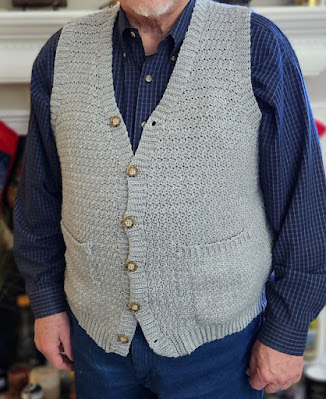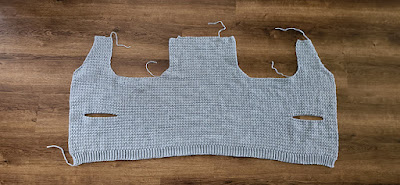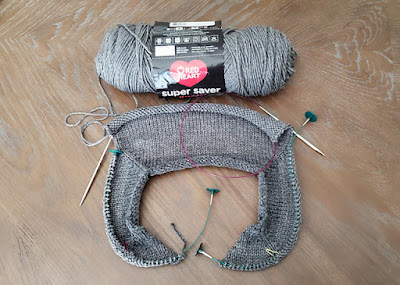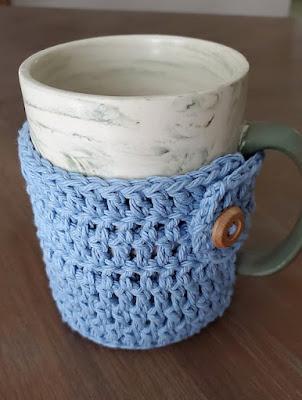Today happens to be my ninth Ravelry-versary (I joined the site on Dec. 1, 2010). And today I completed my 253rd project post there - a
Sheepish Pajama Stuffie Pillow that I'm inordinately proud of. (I know - I'm weird. My husband already told me.)
For some years now I’ve had a project concept rolling around in my head where I wanted to make a stuffie pillow cover to keep my pajamas in during the day (instead of just folding them and leaving them on top of the bed - tacky, amirite??).
I found this
Aran Fleck colorway by Red Heart and thought it would be perfect for crafting my sheep pillow’s “fleece” because the flecks in the yarn, to me, represent the random bits of grass and leaves and twigs that would naturally get tangled in a sheep’s fleece as it forages across the countryside. So figuring out which yarn to use for my project was not an issue.
What proved to be more difficult, however, was HOW to knit or crochet the actual pillow cover. I started and ripped back and started and ripped back I don’t know how many times (remember, I said this project has taken years for me to get it off the ground). My original idea was to crochet a pillow cover using the bobble stitch, because solid rows of bobble stitch totally look like fluffy sheep’s fleece. But every time I got going on a bobble stitch piece, I ended up with something that was either way too large (working flat) or way too wavy (working in the round), and I just wasn’t happy with any of them, and there didn’t seem to be any patterns out there where someone else had figured out the process in a way that would fit what I wanted my pajama pillow cover to be.
I came across a pattern by Purl Soho for a knitted
Bobble Sheep Pillow that is SO adorable, and on first glance it appears to be just about the right size to be a pajama stuffie pillow cover. But the pattern is written for a heavier yarn than the Red Heart I have, and I just didn’t have the energy to try to convert the pattern to be the correct size at the gauge I’d be working in. Sigh! Maybe another time.
There are also many cute sheep hat crochet patterns out there (like
this one, or
this one, or
this one), but again, none was easily translated into a pillow form that satisfied what I was looking for.
I had recently done some crochet projects (like this lovely autumn
Little Rustic Pumpkin, pattern
here) using the HDC in the third loop stitch, which, when worked flat, produces a fabric that strongly resembles knitted ribbing. I thought about it for a while and finally concluded that although it wouldn’t produce the cute, bobble-y, fluffy sheep-fleece look I had originally wanted, a sheep pillow done in ribbing would still look sufficiently sheep-y (texture-y) to get the job done. So I decided to give the crocheted ribbing fabric a chance.
I used a 7-inch by 12-inch
microbead bolster pillow as a size guide for the body of the pajama stuffie pillow cover. (The finished cover fits over that bolster pillow perfectly. LOL)

In the Aran Fleck yarn, first I crocheted a flat circle using all FPDC stitches until it was about 7 inches in diameter. This would be one end of the pajama stuffie pillow cover. Working in the back loops only, I worked one row of HDC around the circle without joining at the end of the row and continued working back and forth in rows in the HDC-third-loop stitch until the body of the pillow cover was about 12 inches long. At this point I cut the yarn and crocheted another flat circle using all FPDC stitches (trying to work the second circle from the outside edge toward the center using decreases just didn’t want to look right … it might be possible to do it that way, but it was easier for me to break the yarn and work the second circle from the center outward). Without cutting the yarn I HDC’d around the circle catching the front loops only of the last row of the body stitches to join the second circle to the body.

This gave me a tube-shaped pillow cover that opens down its full length. To add a placket for buttoning, I joined the yarn along one edge of the opening and SC’d evenly across. Turned work and HDC’d across. Turned work and HDC’d across, chaining 1 and skipping a stitch where I wanted to place a button. Turned work and worked a final row of HDC across, including in the chain spaces. Finish off, weave in ends, and sew on buttons to line up with the buttonholes, and that’s all there is to making the body of the Sheepish Pajama Stuffie Pillow.

Originally I intended to use a zipper to close the pillow cover, but in the end I went with buttons (again, trying to keep it as simple as possible … remind me sometime to tell you the story of how I actually did throw a white zipper for this project into my shopping cart at the store, but when we got to the checkout the conveyor belt actually ATE my zipper - the belt just swallowed it where it turns and feeds down inside the cabinet - so I decided then and there that perhaps I wasn’t meant to use a zipper for this). I bought the buttons
at Amazon.
For the face, using the black yarn, I emulated Kim Guzman’s (Crochet Kim) design for her
Farmhouse Love My Sheep Pillow, free pattern found
at this link. For her design Kim sews the face piece directly onto the front of her pillow as a sort of 3-D applique, lightly stuffing the face before stitching the opening closed. But for me, using a 5.5mm hook, the head turned out to be a bit taller than the end of my pillow cover, so I crocheted a second head piece and whip-stitched the two together, lightly stuffing the head before stitching the opening closed.
I wanted my sheep to be “sleeping,” so I embroidered sleeping eyes onto the face with a scrap of white yarn before sewing the two head pieces together, and I also stitched the ears to the front head piece (using the yarn tails left after working the ears) before sewing the head pieces together to make it easier to attach the ears where I wanted them.
I stuffed the pajama stuffie pillow cover with the microbead bolster pillow to plump it up for the photo shoot, but now my Sheepish Pajama Stuffie Pillow cover is ready to take its place on my bed to keep my pajamas stashed away and neatly out of sight. 😄



















































